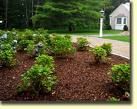Jerry Goodspeed with the USU Extension helps identify which will work best for you.
1. Plastic, the old standby: Very short term, just a couple of years. Does not break down, but does break apart. No water or air penetration.
2. Weed fabric Barriers: You get what you pay for. Can be expensive. 3 oz.per square yard is the best. Should be stronger than you. Look for spunbonded. Woven is also good, but may have some gaps for weeds such as morning glory (field bindweed). Needs to be covered with another mulch. Long term weed control.
3. Bark: Ornamental. 2 to 4 inches deep. Course vs. medium vs. fine. Needs to be replenished every couple of years. Can be expensive. Not a complete weed control, will still have some come through.
4. Compost: Helps control weeds and improve the soil. 2 to 4 inches deep. Not a weed eliminator, just a weed reducer. Must be replenished every year.
5. Paper in the garden: Very inexpensive. Cover with one to two inches of compost or yard and garden waste. Till into garden in fall. Improves soil. Gives plants something to read while they are growing…
6. Rubber or synthetic products: New on the market. Do not break down like organic mulches. Look good longer, but not a great weed controller unless used with weed fabric.
Jerry Goodspeed is a horticulturist with the Utah State University Extension. He also serves as Director for the Ogden Botanical Gardens.
http://extension.usu.edu/weber/htm/horticulture















Add comment